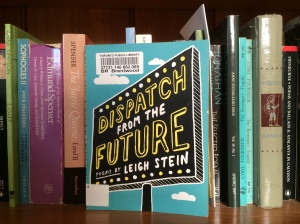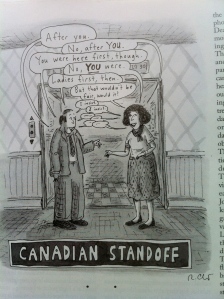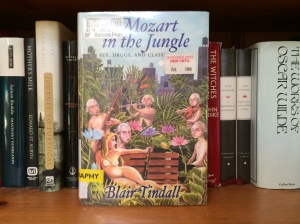
Leigh Stein, Dispatch From The Future (2012)
Many poets – mainly insecure ones, of which there is no shortage – are in love with difficulty – or, more precisely, they are in love with the idea of their work being perceived as difficult. There is a romance to the difficult, born out of its association with genius, that makes it very attractive. But the difficulty we find in works of genius comes from an attempt to communicate genuinely complex ideas – and alas, genius is rare. For most poets, the desire to produce difficult works of genius tends to collapse into masking mediocrity with willful obscurity.
Why this tendency to lean on obscurity as a substitute for difficulty? Many poets just don’t have anything that profound to say, and that makes clarity tremendously risky. If you express yourself clearly, there is a good chance someone – perhaps a lot of people – will find what you’re saying trite or shallow, which would only confirm the insecure writer’s fear that they have nothing interesting or original to say. If you’re a poet, then, and you’re not certain that you have anything interesting to say, how much safer it is to express yourself in the most obscure way possible. When people are confronted with a poem that is clear, they tend to evaluate its “sense”; when they’re confronted with a poem they find obscure, they may assume that the writer is saying something that is too complex for them to understand. Obscurity thus becomes the perfect cover for vacuity.
The poems in Leigh Stein’s collection, Dispatch From The Future, read as if they have been studiously composed to avoid making conventional sense. As you read them, you often feel, over a stretch of lines, that there is a narrative taking shape or an idea being developed; and then there will come a sudden wrenching aside of the poem into another, seemingly unrelated direction, as if the poet has caught herself making sense and veered sharply into the thickets of obscurity out of fear that she might reveal something – or worse, reveal that there is nothing to reveal.
There are two references to Canada in two different poems. Though both references are passing ones, I’ll quote the poems in their entirety – partly for context, and partly because I find it disrespectful to both poets and poems to chop out a little chunk a few lines long.
Try A Little (Canadian) Tenderness
Here’s the first:
Katharine Tillman vs. Lake Michigan
Mitsu flips a lot of coins. Katharine told me that once
she was in the middle of a tantrum and a coin
told him he should love her, and yet, he wasn’t
satisfied so he went to the dictionary and closed
his eyes and found a word and when she asked
what word he found, the only thing he would tell her
was that he was one step closer to the secret
of the universe. Can you tell me what it rhymes with,
she asked him. Is it a verb? Is it a country? Have I
been there? Will you write its name on my back
while we sit on the pier and watch the blue dusk
chase the sun to Jersey? The last time I ever
saw Katharine she asked me the name of the lake
in the distance and I said Michigan and she said
she’d heard of it, and then she showed me the diaries
she kept when she lived under the overpass
near Truth or Consequences, New Mexico,
when all she had was a travel Scrabble set and
the reason she’d run away. Milan Kundera
has a lot to say about our tenuous insignificance.
When he wants to decide something he, too,
flips a coin, but in his case heads is Little Rock,
Arkansas, and tails is Little Rock, Arkansas, and
it’s just a matter of who to blindfold and bring with
on his motorcycle. On page one hundred and seven
of The Unbearable Lightness of Being, I get lost
driving Katharine to the airport. On page one hundred
and forty nine, Tereza dreams that they take her away.
After I see Katharine for the last time I don’t go home;
I go to Prague and it’s 1968 and the man I love won’t
touch me; he just holds an empty gun to my temple
and even though we both know it’s empty there’s the small
comfort that the worst thing that could possibly happen
would be the thing I want most. Mitsu says the secret
of the universe is obvious in any planetary shaped
object you can find on the floor of a parking garage.
Katharine says how. I say I want to move to Canada;
the only tenderness anyone can get around here
is in the time it takes him to untie my wrists. (22-23)
Several elements in this poem recur throughout the book and seem to mark points of interest (“obsessions” might be more apt) for Stein: women in peril, usually at the hands of men; references to Milan Kundera (a writer who seems sophisticated when you’re 18); suicidal thoughts and the desire for death.
I’m not going to attempt to interpret the whole poem – you can tackle that yourself if you’re so inclined. Canada appears at the very end, as a place to which the speaker wants to move. She doesn’t explicitly say why, but if we take the next two lines as explanatory (and that seems to me the most reasonable way to read them), then her desire to move to Canada comes from the feeling that there is not enough tenderness in her life in the U.S., and moving north of the border might be a way to find some.
This idea of searching for tenderness in Canada represents yet another iteration of the familiar American idea that Canada is a gentler, more pacifist nation than the U.S., and that those seeking to escape the violent, martial side of the American character (represented in this poem by the man who apparently keeps the speaker tied up most of the time) can do so here.
You Can’t Have Paris (But You Can Have Canada)
On to the second Canadian reference:
Choose Your Own Canadian Wilderness
My favourite book is the one with the woman
who wears a balaclava every time she goes
under the viaduct because it’s Canada, and
because she’s married to a man who loves
her sister, and because if her family found her
under the viaduct, she would lose everything;
more than that, she would lose the end of the story
he began. Il était une fois, he said, there are rugs
made by children who go blind and turn
to crime, and/or rescuing sacrificial virgins
from the palace the night before the sacrifice.
Turn one page if you want to be the woman,
listening to the story, but you’ll have to
keep the hat on. Turn three if you’d rather
be a girl alone in a bed, waiting. I was
always that girl: you’re alone and
they’ve already cut out your tongue
and in the morning they’ll take you
to the top of a high hill, so what can you
do but follow the blind boy, watch
as he puts the body of the strangled guard
in your bed, in your place, follow as he leads
you through the air ventilation system and over
the palace walls? I never chose any other way
because what could the woman do but love him
and listen to a story that wasn’t about her.
After you get over the walls you run
through the darkness, the darkness that isn’t
darkness to the blind boy because of his blindness,
the silent darkness to you who can’t describe it,
you run until you turn the page, but then instead
of safety, a valley, and the woman under the viaduct
puts her skirt on and goes back home and you think
you’ve ended up in the wrong story, but months later
she gets a phone call saying the man was killed
in the Spanish Civil War and that’s the end
because the only person who knows
what happened to you is dead. (45-46)
The title of the poem refers to the “Choose Your Own Adventure” series of children’s books (which are another recurring reference/obsession for Stein – she even mentions “the great R.A. Montgomery” in a couple of poems), and the poem itself recalls the format of those books with its “turn one page if … turn three pages if…” conceit. The direct association of Canada with the idea of “wilderness” should surprise no one at this point – we are, by now, quite familiar with the fact that many Americans think of our country as little more than an uninterrupted band of forest topped with an uninterrupted band of tundra.
The idea of choice does, however, complicate this impression: apparently there are different Canadian wildernesses, which are distinct enough from one another that a person could make some sort of choice among them. But the poem itself never explains the differences.
And then we have “the woman / who wears a balaclava every time she goes / under the viaduct because it’s Canada”. Presumably when we are told the woman wore a balaclava “because it’s Canada,” we are meant to understand, “and Canada, as everyone in the United States knows, is cold all the time and therefore the wearing of balaclavas is essential in order to prevent your skin from instantly freezing the moment you step outside” (or something along those lines). So Canada is cold – another common idea.
And does “Il etait une fois,” which is the French equivalent of “Once upon a time,” appear here because of some half-buried notion that everyone in Canada speaks French? It’s difficult to say for certain, but the possibility hums in the air.
From there Stein drops Canada, but ultimately, a reading of the poem returns us to the question of the title. Why did Stein give the poem that particular title? In what sense is anyone in the poem choosing a Canadian wilderness?
I don’t think there is necessarily a linear link between the title and the body of the poem, nor does there need to be. To me, the title is of a piece with what follows. There is a bleakness, verging on despair, in the implication that while you can choose your own Canadian wilderness, you can’t choose anything other than a Canadian wilderness – you can’t choose your own Parisian arrondissement, for example, or your own cottage in the Lake District – it’s just one Canadian wilderness or another.
Likewise the poem, which seems to be about women caught in threatening narratives that offer no escape or resolution, creates an overall sense of repetitive hopelessness, and the idea of choosing a Canadian wilderness is emblematic of that hopelessness. This is quite different from the idea of Canada in the previous poem: there, Canada represented a hope for refuge from the man who kept the woman tied up; here, there doesn’t seem to be any possibility of escape, except perhaps to some Canadian wilderness, which is apparently not a very appealing prospect.









